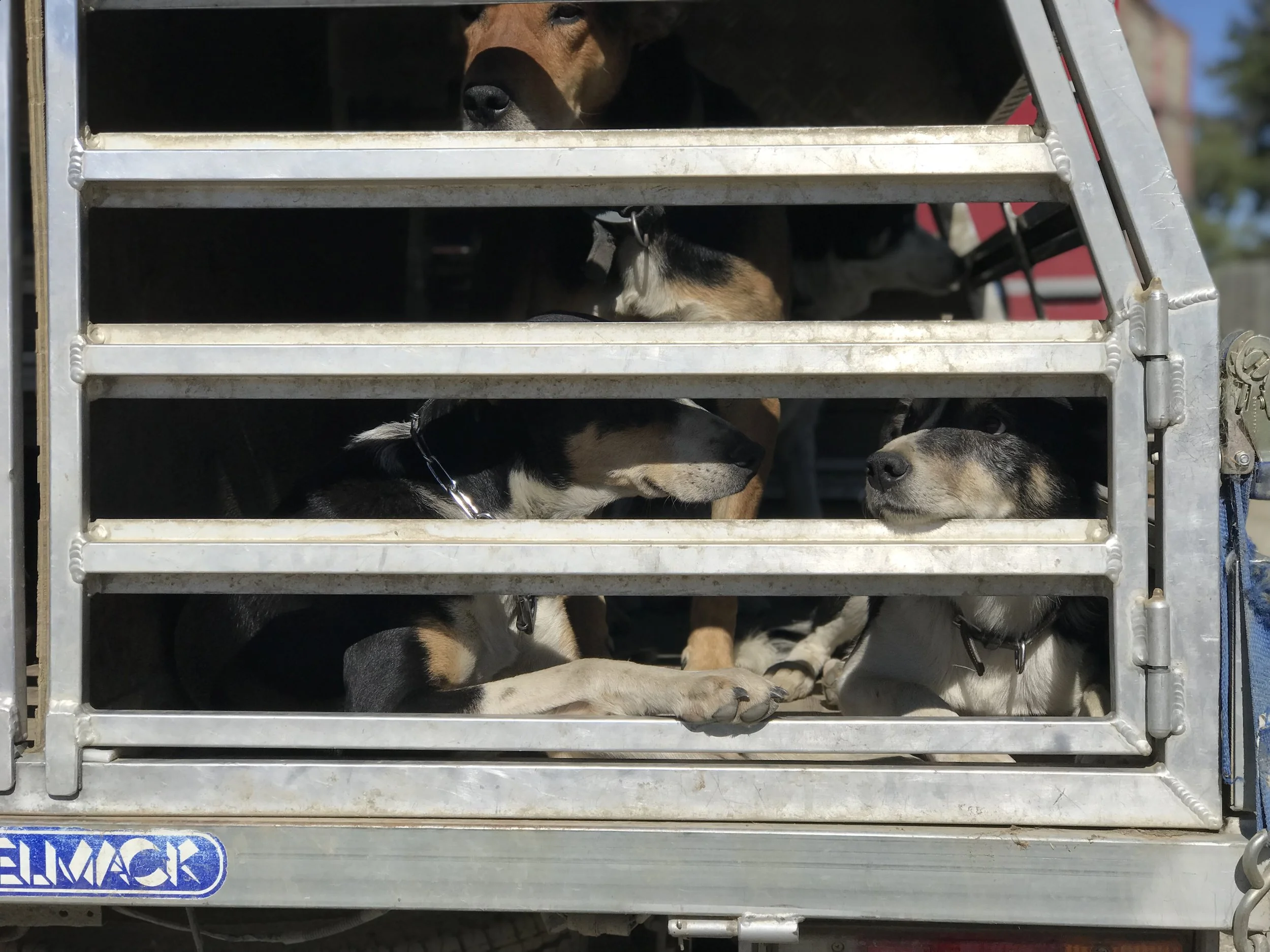Early findings from the New Zealand Working Dog Project
Farm dogs have been part of the fabric of New Zealand life for 150 years, yet little is known about important aspects of their health, productivity and longevity. The TeamMate New Zealand Working Dog Project aims to change that. Jacqui Gibson reports from the project’s recent South Island roadshow
Entrance to Earnscleugh Station, Central Otago (image by Jacqui Gibson).
It’s a dry, hot afternoon in March when the last of the crew from the TeamMate New Zealand Working Dog Project pull in to Earnscleugh Station.
A flock of Merino sheep is being expertly herded by two farm dogs and a no-nonsense farmer. Pedigree cattle are making their way noisily into two red cattle trucks. Nearby, in Earnscleugh’s eight-stand woolshed, the lunchroom kettle is boiling and the table is set with sandwiches, cakes and juice. The few remnants of high-grade Merino wool still left on the floor are being swept up, while three rows of plastic chairs are being grouped around a projector screen near the woolshed’s main entrance.
At 3.30pm, Vetlife veterinarian Lori Linney of Alexandra, Vetlife project manager Helen Williamson of Timaru, and Naomi Cogger, a founding director of Massey University’s Working Dog Centre, will take the floor.
The three women will spend the following hour presenting their interim findings from the five-year TeamMate research project, a world-first observational project that has so far collated data from more than a dozen veterinarians, 628 working dogs, 127 dog owners and 118 farms throughout the central South Island.
Before the formal presentation begins, Naomi gazes out the lunchroom window at the clear blue skies, tussock-covered hills and bizarre schist rock formations and explains to VetScript what today’s presentation – and the others that the team has done at seven locations around the South Island – means to her.
“It’s great to be here. It’s great to present our early findings from the study. We’ve got a lot more data to enter and more than 12 months of analysis to do, so these findings are really just the start of what’s to come in journal articles, conference presentations and so on.”
Very little is known about farm dog health, productivity and longevity, despite 150 years of farming and farm dogs in New Zealand, says Naomi.
A previous study, sponsored by a commercial dog food company, looked at farm dog feeding habits. Another study led by Associate Professor Nick Cave explored the reasons working dogs presented at veterinarian clinics. Another identified the number of farm dogs typically found on New Zealand farms and the common parasites they carry. And an Australian study found that a single farm dog typically contributes around $40,000 to a farm’s productivity over the course of its lifetime.
“Each study has given us a piece of the puzzle,” says Naomi. “With the TeamMate study, we want to fully understand the bigger picture. We want to gather the depth and range of information needed to really inform farmers and change veterinary study and practice.
“The study is definitely on track to deliver. We know it’s the only longitudinal study of working farm dogs focused on such a wide range of issues, from health and wellbeing to productivity and longevity.
“It’s the only study with follow-up. And it’s the only study where veterinarians have had the chance to put their hands on healthy farm dogs more than once in a 12-month period. Will it be career defining for those of us involved in the study? Yes, I think in time we’ll find it will be.”
Working farm dogs, Central Otago, New Zealand (image by Jacqui Gibson).
At Earnscleugh, the audience of participating farmers learns that the study involved farmers and dogs from Central Otago farms of around 150 hectares.
Participants were mostly men (92%) aged between 41 and 50 with between four and five dogs and more than 20 years’ experience in owning dogs.
The average age of farm dogs was four to seven years, split between male (54%) and female (46%) dogs and four main types: Heading dogs (51%), Huntaways (44%), Handy (three percent) and Beardie (two percent).
Every dog was examined by a veterinarian twice a year for five years. Throughout the study, data was collected on each dog’s feeding regime, worming programme, kennel, mating history, work history, purchase price, morphology and body condition.
Data was also gathered on the reasons, if relevant, for participants exiting the study. In the study’s third year, 100 dogs were fixed with Heyrex monitors (super lightweight, Fitbit-like devices for dogs) for 14 months.
Lori says: “We’ve yet to crunch the Heyrex data, but we’re expecting extra insights into the activity levels of farm dogs, how much they rest, their temperatures and the extent to which they scratch.
“The purpose of this data, together with other information we’ve collected, is to rigorously test our assumptions about farm dogs. Yes, we know they’re fit and hard-working, but, based on our observations so far, we’re finding they’re actually more like marathon runners or elite athletes.
“If that’s the case, then we need to look at the number of calories they burn each day and the diet that would best support or enhance their performance. With good, reliable data these are the kinds of issue we can address.”
In the meantime, says Helen, the team has plenty of advice ready to share from the study.
For example, farmers feeding their animals dog roll need to cut it into small chunks to prevent them choking to death (anecdotally, seven owners in the study lost farm dogs to choking).
Farmers also need to dose their dogs for sheep measles monthly, and keep it up. Preventing dogs scavenging, and feeding dogs sheep meat frozen for at least seven days are other tips for controlling sheep measles on farm.
The most injury-prone areas of a working dog are hips, stifle and carpus, so farmers could start to look at ways to lessen the stress on these parts of a working dog’s body.
Next steps, says Naomi, will involve exploring differences in injury profiles between heading dogs and Huntaways. These breeds work very differently with heading dogs tending to get close to stock and be more confrontational.
The team also identified reduced range of joint motion as a possible indicator of limited career longevity, says Lori.
Data showed that dogs with an abnormal joint motion range were 3.3 times more likely to be dead or retired within six months than dogs with no problems.
Dogs with an abnormal gait when trotting were 2.8 times more likely to be dead or retired within six months.
“It’s not an absolute indicator,” says Lori, “but I think if I were looking at investing $8,000 in a farm dog and I were presented with a dog showing reduced range of joint motion, I’d probably pass on buying it.”
Central Otago, New Zealand (image by Jacqui Gibson).
Earnscleugh Station farmer and veterinarian Amanda Campbell, who hosted the TeamMate presentation, says Earnscleugh had five dogs in the study.
The 21,000-hectare high-country farm produces 100 tonnes of high-quality Merino wool every year and runs a pedigree Merino and cattle stud operation.
“You just can’t do this work without dogs. They’re a significant asset,” she says.
“So, it’s great to learn more about how to care for them as athletes and keep them going for longer. I think, over time, we appreciate our good dogs more. You appreciate how many hours it takes to make a good dog great. Of course, a farmer wants to train a dog once and have that dog last eight years.”
Shane Lyon, who also attended the TeamMate presentation, uses a team of seven farm dogs – Ralph, Pip, Kate, King, Dodge, Kin and Sarge – to help him run Olrig Station in Alexandra.
“I see my dogs as both workers and members of the family, so I’m definitely open to professional advice about how to care for them and keep them fit and healthy.”
Chatto Creek farmer Bill Hinchey had six dogs in the study and is keenly awaiting more tips and advice from the team.
“I’m probably a bit impatient for the full results because I know it’ll change the way I do things,” he says.
“Over the years I’ve become much better at looking after my dogs. I use coats now. That was something we just didn’t do a decade ago.
“Being part of the study pushed me to think much more about what I feed my dogs. I give them cooked offal regularly now after noticing a difference in three weeks. They look so much healthier and their coats are better. I’m definitely keen to hear more from the study team – in fact, the sooner the better, in my view.”
WORKING DOG PROJECT – AT A GLANCE
» World-first longitudinal study into working farm dogs.
» A Vetlife and Massey University Working Dog Centre project.
» Looked at farm dog feeding, housing, general health, training and condition, disease and injury, career duration and risk factors for disease, injury and end of career.
» Involved more than 628 dogs, 127 dog owners, 118 farms and 12 veterinarians.
» Sponsored by Masterpet, Virbac, Zoetis and Gribbles Veterinary.
» Early findings from the study were presented at a five-day roadshow that started in Canterbury’s Little River and travelled to Dunsandel, Oxford, Oamaru, Pleasant Point, Wanaka and Alexandra in March.
This story was first published in VetScript magazine.



